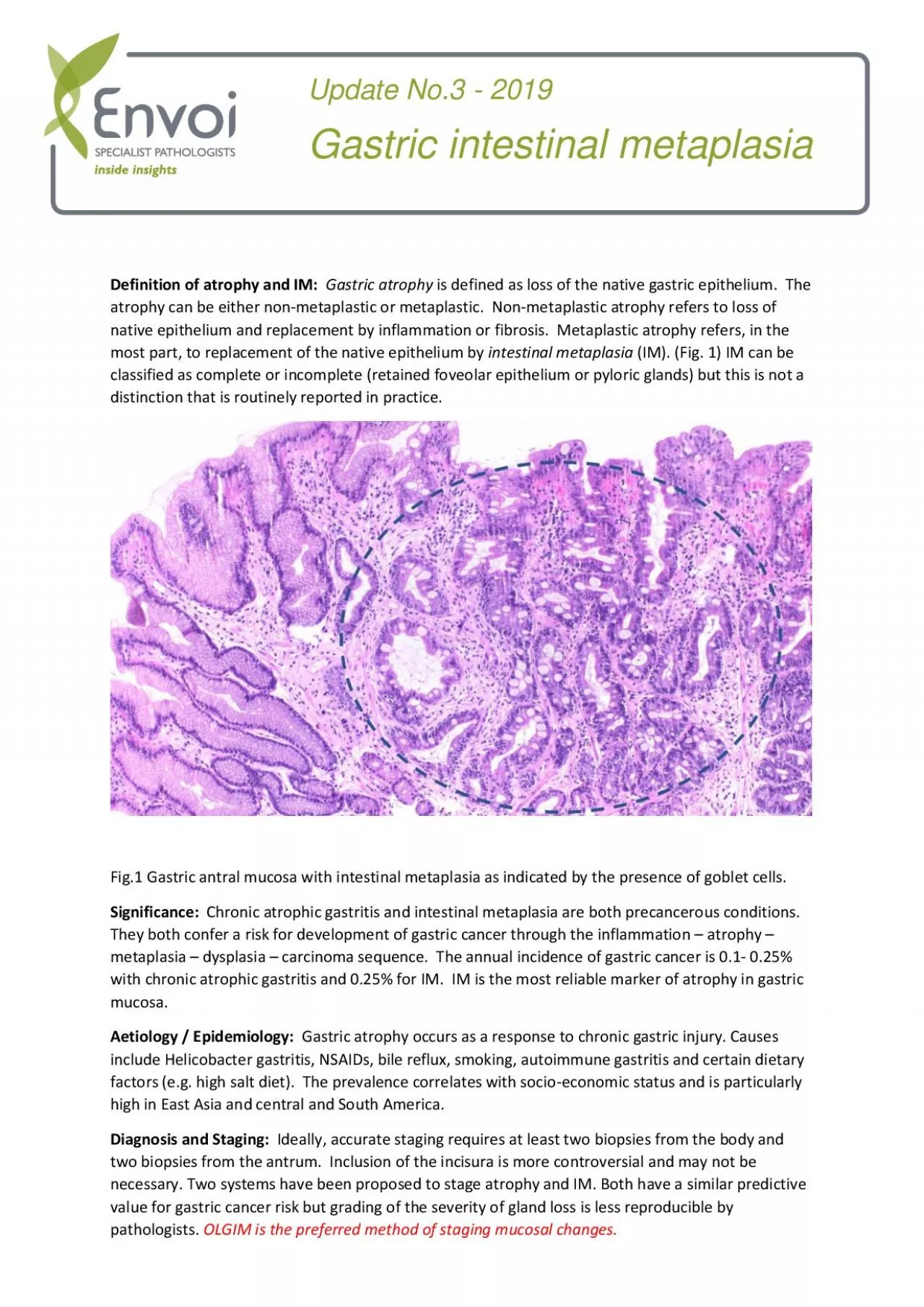

of atrophy and IM Gastric atrophy is defined as loss of the native gastric epithelium The atrophy can be either non metaplastic or metaplastic Non metaplastic atrophy refers to loss of nat ID: 955817
Download Pdf The PPT/PDF document "Definition" is the property of its rightful owner. Permission is granted to download and print the materials on this web site for personal, non-commercial use only, and to display it on your personal computer provided you do not modify the materials and that you retain all copyright notices contained in the materials. By downloading content from our website, you accept the terms of this agreement.
Definition of atrophy and IM : Gastric atrophy is defined as loss of the native gastric epithelium. The atrophy can be either non - metaplastic or metaplastic. Non - metaplastic atrophy refers to loss of native epithelium and replacement by inflammation or fibrosis. Metaplastic atrophy refers, in the m ost part, to replacement of the native epithelium by intestinal metaplasia (IM). ( Fig . 1) IM can be classified as complete or incomplete (retained foveolar epithelium or pyloric glands) but this is not a distinction that is routinely reported in practice. Fig.1 Gastric ant ral mucosa with intestinal metaplasia as indicated by the presence of go ble t cells. Signific ance: Chronic atrophic gastritis and intestinal metaplasia are both precancerous conditions. They both confer a risk for development of gastric cancer through the inflammation – atrophy – metaplasia – dysplasia – carcinoma sequence. The annual incidence of gastric cancer is 0.1 - 0.25% with chronic atrophic gastritis and 0.25% for IM. IM is the most reliable marker of atrophy in gastric mucosa . Aetiology / E pidemiology: Gastric atrophy occurs as a response to chronic gastric injury. Causes include Helic obacter gastritis, NSAIDs, bile reflux, smoking, autoimmune gastritis and certain dietary factors (e.g. high salt diet). The prevalence correlates with socio - economic status and is particularly high in East Asia and central and South America. Diagnosis an d Staging: Ideally, accurate staging requires at least two biopsies from the body and two biopsies from the antrum. Inclusion of the incisura is more controversial and may not be necessary. Two systems have been proposed to stage atrophy and IM. Both hav e a similar predictive value for gastric cancer risk but grading of the severity of gland loss is less reproducible by pathologists. OLGIM is the preferred method of staging mucosal changes. Update No. 3 - 201 9 Gastric intestinal metaplasia • Operative Link Gastritis Assessment (OLGA) – atrophy is defined as loss of appropriate glands with or without metaplasia ( intestinal o r pseudo - pyloric). The severity is assessed at each site (body, antrum and i
ncisura angularis). • Operative Link Gastritis Intestinal Metaplasia (OLGIM) - Only the extent and site of IM is assessed. The severity is graded as: none; mild 1 - 30%; moderate 31 - 60%; severe �60%. The aggregate data is used to determine an overall stage. • Advanced stages of atrophic gastritis are defined as significant (moderate to mark ed) atrophy or IM affecting both antral and corpus mucosa. (OLGA/OLGIM III/IV) Prediction of subsequent dysplasia or malignancy: The identification of atrophy and IM is relevant only as a marker of risk of subsequent neoplasia in the stomach. Other facto rs that may influence the risk for cancer are: • Incomplete IM – subtyping of IM is not however routinely reported • Family history – present in 10% cases although most gastric cancers are sporadic • Persistent H pylori infection • Autoimmune gastritis Definition of dysplasia: Gastric dysplasia is defined as neoplastic epithelium without evidence of invasion. Based on the degree of architectural and cytological atypia it is graded as low or high grade. Surveillance : Surveillanc e allows detection of dysplastic lesions at early stages which may be amenable to endoscopic resection. European surveillance guidelines have been recently been updated (Management of epithelial precancerous conditions and lesions in the stomach MAPS II, 2019). The recommendations can be summarised as follows: • Atrophy antrum, no IM No surveillance • IM at single location (antrum or body) No surveillance • IM at single location + family history, incomplete IM, or persistent HP Consider re - biopsy 3yrs • Advanced atrophic gastritis (OLGA/OLGIM III/IV) Endoscopy every 3yrs • Advanced atrophic gastritis (OLGA/OLGIM III/IV) + family history Endoscopy every 1 - 2yrs • Autoimmune gastritis Endoscopy every 3 - 5yrs Further reading: 1. OLGA gastritis staging for the prediction of gastric cancer risk. AJG; 2018;113:1621 - 1628 2. Management of epithelial precancerous conditions and lesions of the stomach (MAPS II). Endoscopy; 2019;51:365 - 38